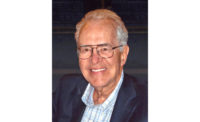Frank D. Welch, FAIA, considered the dean of Texas architects, died last week in Dallas at the age of 90. His prominence in the architectural culture of the Southwest cannot be overstated, particularly in the way that his work married the vernacular with the contemporary, as well as his use of materials and his intimate understanding of landscape, light, and spirit of place.
Welch was born in 1927 in Paris, Texas, and raised in Sherman, developing an early curiosity about art, photography, and the world far beyond his own immediate surroundings. He pursued architecture at Texas A&M and received a Fulbright to travel to Paris in the early 1950s, where he intended to study at the Ecole des Beaux-Arts—but he devoted much of his time there instead to black and white street photography, with a new Leica 3C. His voracious interest in photography, art, movies, music, and literature continued throughout his life.
But architecture was his life’s work, and it was his diversity of experience and erudition that gave such weight and meaning to his work. At a Houston dinner party in the mid-50s, he met his great mentor, O’Neil Ford; they stayed up most of the night talking, and by morning Welch was hired by the legendary Texas architect. Ford looked deeply into the built work in the state, distilling the forms of Spanish and German stonework, as well as the metal roofs of South Texas and the central Hill Country, to derive a set of elements now considered to constitute a “Texas architecture.’”
Ford sent Welch to supervise the work on the new Texas Instruments building in Richardson, Texas, where the young architect saw the unique reconciliation of ancient and modern pursued by Ford and absorbed the nuances of Ford’s design and construction.
Welch later set up his own office in Midland, where his client base derived their wealth from oil; those who sought him out were particularly worldly and wanted his unpretentious but beautifully detailed modernist houses of stone, glass, and wood.
In 1966, Welch created what would be his signature work of architecture: a simple shelter, with no electricity and a water well, on a rock bluff overlooking the vast, flat West Texas landscape. Named cryptically after the small stone cairns left by migrant workers, it was known as “The Birthday” and was a prime example of Kenneth Frampton’s ideas on a critical regionalism 20 years later. A 20-foot square stone box in plan, with a fireplace / apse at its east end, it opened to the north through two sliding wood shutters: it was a view with a room. It’s lithic origins—the stone was quarried on the ranch—simple detailing, and linear clerestory made it archaic and profound. So beloved and significant was The Birthday that in 1997, the Texas Society of Architects gave it the 25-Year Award jointly with Louis Kahn’s Kimbell Art Museum—the only time the honor was been given to two buildings at once.
While known primarily for his residential work, Welch’s practice, which he eventually moved to Dallas, left important structures of many types, including mid-rise office buildings and religious, academic, scientific, and commercial structures. His palette was always understated and refined, and dealt elegantly with light, shade, wind, and water.
His work was recognized with design awards in every decade of his practice, and he received numerous major professional awards from the Texas Society of Architects, including the Firm Award in 1998, the Medal for Lifetime Achievement in Honor of Llewellyn W. Pitts, and the inaugural Medal for Design Achievement in Honor of O’Neil Ford in 2015. Last February, Welch was honored with a Texas Cultural Trust Medal of the Arts.
He wrote frequently throughout his professional life and was known for his book Philip Johnson & Texas (2000), as well as his memoirs On Becoming an Architect (2014) and Thirty Houses (2015). He contributed to Texas Architect magazine and other publications, as well as teaching, lecturing and serving on juries. He was a mentor to many younger colleagues.
His breadth of concerns and wide intellectual interests were manifested in his architecture. It had visual simplicity and the rich intrinsic depth of history. And, in his words, it “avoided cleverness at all costs.”








Post a comment to this article
Report Abusive Comment